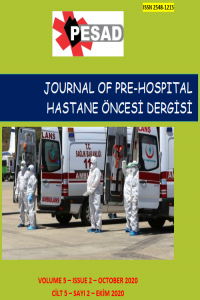Düzeltme: OBSTETRİK TRİYAJ MEMNUNİYET DEĞERLENDİRME ÖLÇEĞİ GEÇERLİK VE GÜVENİRLİK ÇALIŞMASI
Obstetrik, Triyaj, Memnuniyet, Ölçek, Geçerlik, Güvenirlik
Düzeltme: OBSTETRIC TRIAGE SATISFACTION ASSESSMENT SCALE VALIDITY AND RELIABILITY STUDY
Obstetrics, Triage, Satisfaction, Scale, Validity, Reliability,
___
- Aksu, G, Eser, MT, Güzeller, CO. (2017). Açımlayıcı ve Doğrulayıcı Faktör Analizi ile Yapısal Eşitlik Modeli Uygulamaları, 1. Baskı. Detay Yayıncılık. Ankara. 2017. s:115-143.
- Albahri, OS, Albahri, AS, Mohammed ,KI, et al. (2018). Systematic review of real-time remote health monitoring system in triage and priority-based sensor technology: Taxonomy, open challenges, motivation and recommendations. Journal of Medical Systems, 42(5): 1-27.
- Alemdar, DK, Özdemir, FK, Tüfekçi, FG. (2004). Triyaj karar verme envanteri’nin Türkçe’ye uyarlanması: Geçerlik ve güvenirlik çalışması. Gümüşhane Üniversitesi Sağlık Bilimleri Dergisi, 4(4): 547-562.
- Angelini, D, Howard, E. (2014). Obstetric triage: a systematic review of the past fifteen years 1998-2013. MCN: The American Journal of Maternal/Child Nursing, 39(5): 284-297.
- Azeredo, TRM, Guedes, HM, de Almeida RAR, et al. (2015). Efficacy of the Manchester Triage System: a systematic review. International Emergency Nursing, 23(2), 47-52.
- Brouns, SH, Mignot-Evers, L, Derkx, F, et al. (2019). Performance of the Manchester triage system in older emergency department patients: a retrospective cohort study. BMC Emergency Medicine, 19(1): 1-11.
- Bullard, MJ, Musgrave, E, Warren, D, el al. (2017). Revisions to the Canadian emergency department triage and acuity scale (CTAS) guidelines 2016. Canadian Journal of Emergency Medicine, 19(2): 18-27.
- Büyükbayram, A, Engin, E. (2018). Acil psikiyatrik bakım ve ruh sağlığı triyajı. Psikiyatri Hemşireliği Dergisi, 9(1): 61-67.
- Büyüköztürk, Ş. (2015). Sosyal bilimler için veri analizi el kitabı. 21. Baskı. Pegem Yayıncılık. Ankara. 2015. s: 93-110.
- Çakır, A. (2014). Faktör Analizi. İstanbul Ticaret Üniversitesi Sosyal Bilimler Enstitüsü. İstanbul.
- Çapık, C. (2014). Geçerlik ve güvenirlik çalışmalarında doğrulayıcı faktör analizinin kullanımı. Anadolu Hemşirelik ve Sağlık Bilimleri Dergisi, 17(3): 196-205.
- Duke, T. (2016). New WHO guidelines on emergency triage assessment and treatment. The Lancet, 387(10020): 721-724.
- Esin, MN. (2014). Veri toplama yöntem ve araçları-veri toplama araçlarının güvenirlik ve geçerliği. Hemşirelikte araştırma: Süreç, uygulama ve kritik. 4. Baskı. Nobel Tıp Kitapevi, İstanbul. 2014. s: 193-235
- Evans, MK, Watts, N, Gratton, R. (2015). Women’s satisfaction with obstetric triage services. Journal of Obstetric, Gynecologic and Neonatal Nursing, 44(6): 693‐700
- Evci, N, Aylar, F. (2017). Derleme: Ölçek geliştirme çalışmalarında doğrulayıcı faktör analizinin kullanımı. Sosyal Bilimler Dergisi, (4):10, 389-412.
- Fakari, FR, Simbar, M. (2019). Obstetric triage scales; a narrative review. Archives of Academic Emergency Medicine, 7(1): e13.
- Güngör, D. (2016). Psikolojide ölçme araçlarının geliştirilmesi ve uyarlanması kılavuzu. Türk psikoloji yazıları, 19(38), 104-112.
- Haruna, J, Minamoto, N, Shiromaru, M, et al. (2022). Emergency nursing-care patient satisfaction scale (Enpss): Development and validation of a patient satisfaction scale with emergency room nursing. In Healthcare, 10(3): 518.
- Karakoç, FY, Dönmez, L. (2014). Ölçek geliştirme çalışmalarında temel ilkeler. Tıp Eğitimi Dünyası, 13(40): 39-49.
- Kenyon, S, Hewison, A, Dann Save et al. (2017). The design and implementation of an obstetric triage system for unscheduled pregnancy related attendances: a mixed methods evaluation. BMC Pregnancy and Childbirth, 17(1): 1-10.
- Kuriyama, A, Urushidani, S, Nakayama, T. (2017). Five-level emergency triage systems: variation in assessment of validity. Emergency Medicine Journal, 34(11): 703-710.
- McCarthy, MF, Pollock, WE, McDonald, SJ. (2022). Implementation of an obstetric triage decision aid into a maternity assessment unit and emergency department. Women and Birth, 35 (3): 275-285.
- Mehta, PK, Carter, T, Vinoya, C, et al. (2017). Understanding high utilization of unscheduled care in pregnant women of low socioeconomic status. Women's Health Issues, 27(4): 441‐ 448.
- Moudi A, Iravani M, Najafian M, et al. (2022). The development and validation of an obstetric triage acuity index: a mixed-method study. The Journal of Maternal-Fetal and Neonatal Medicine, 35(9): 1719-1729.
- Rashidi Fakari, F, Simbar, M, Safari, S, Rashidi Fakari, F, Moghadas Inanloo, E, Molaie L. (2020). Explaining the quality index of obstetric triage. Hayat Journal, 25(4): 356‐365.
- Robert, B, Mol, KS. (2020). Obstetric triage scales. International Journal of Obstetrics, Perinatal and Neonatal Nursing, 6(2): 84-91.
- Simbar, M, Rashidi Fakari, F, Ebadi, A, et al. (2022). The satisfaction assessment tool for obstetrics triage (SATOT): Development and psychometric properties. Journal of Midwifery and Reproductive Health, 10(1): 3075-3083.
- Veit‐Rubin, N, Brossard, P, Gayet‐Ageron, A, et al. (2017). Validation of an emergency triage scale for obstetrics and gynaecology: a prospective study. BJOG: An International Journal of Obstetrics and Gynaecology, 124(12):1867-1873.
- Yurdugül H. (2005). Using content validity indexes for content validity in scale development studies. XIV Ulusal Eğitim Bilimleri Kongresi, s:771–775.
- Zachariasse, JM, van der Hagen, V, Seiger N, et al. (2019). Performance of triage systems in emergency care: a systematic review and meta-analysis. BMJ Open, 9(5), e026471.
- Başlangıç: 2016
- Yayıncı: Paramedik Eğitiminde Standardizasyon ve Akreditasyon Derneği
ARAÇ İÇİ TRAFİK KAZASI SONRASI CRUSH SENDROMU İLE TAKİP EDİLEN HASTANIN KLİNİK SEYRİ: OLGU SUNUMU
Ülgen PANUŞ, Seçil BEYECE İNCAZLI, Ali EKŞİ
Düzeltme: ARTVİN İLİ SANAYİ SİTESİNDE ÇALIŞANLARIN İLK YARDIM BİLGİ DÜZEYLERİNİN BELİRLENMESİ
Elif IŞIK DEMİRARSLAN, Sevil ÇINAR ÖZBAY, Yalçın KANBAY
ÜNİVERSİTE ÖĞRENCİLERİNİN SAĞLIK OKURYAZARLIĞI DÜZEYLERİ VE HASTA HAKLARI İLE İLİŞKİLİ FAKTÖRLER
Ayten KÜÇÜK, Kamuran ÇALIŞ İBİŞ, Gülay MADAN, Nurhan AYTUĞ KANBER
Esra BEKİRCAN, Fatma BOĞAN, Emrullah YILDIRIM
SAĞLIK SİSTEMLERİ İÇİN AFET ve ACİL DURUM YÖNETİMİ PLANLARI
Bülent ÖZMEN, Sıdıka TEKELİ YEŞİL
Düzeltme: OBSTETRİK TRİYAJ MEMNUNİYET DEĞERLENDİRME ÖLÇEĞİ GEÇERLİK VE GÜVENİRLİK ÇALIŞMASI
Emine Serap ÇAĞAN, Ebru SOLMAZ, Rumeysa TAŞKIN, Elmin EMİNOV
HASTANE ÖNCESİ YAKLAŞIMI ETKİLEYEN BİR PARAMETRE: KAPİLLER LAKTAT ÖLÇÜMÜ
